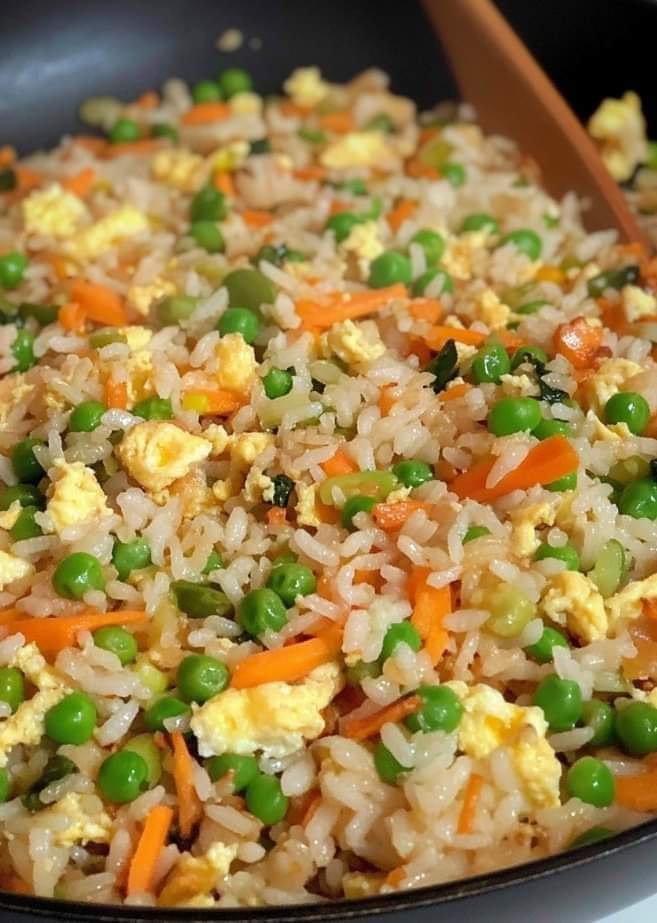ADVERTISEMENT
Instructions: How to Make Fried Rice Better Than Takeout
Step 1: Prepare Your Rice
- Use cold rice: If you’re using leftover rice, take it straight from the fridge. If you don’t have leftover rice, cook fresh rice and allow it to cool on a tray or in the refrigerator for about 30 minutes. Cold rice grains are less sticky and will fry up better without clumping together.
- Break up the rice: Before cooking, use your fingers or a fork to break up any clumps of rice. This will help each grain fry evenly and prevent a soggy dish.
Step 2: Cook the Eggs
- Scramble the eggs: Heat a wok or large skillet over medium-high heat. Add a teaspoon of oil to the pan and swirl it around to coat the bottom. Pour in the beaten eggs, and scramble them, cooking for about 1-2 minutes until just set. Remove the eggs from the pan and set them aside.
Step 3: Stir-Fry the Veggies
- Cook the vegetables: Add the remaining tablespoon of oil to the pan. Once hot, add the diced onions and cook for about 2 minutes, or until softened. Add the garlic and stir for another 30 seconds until fragrant.
- Add frozen peas and carrots: If you’re using frozen veggies, add them to the pan and stir-fry for another 2 minutes, until heated through. You can also use fresh vegetables like bell peppers, mushrooms, or snap peas for extra crunch and flavor.
Step 4: Add the Rice and Seasonings
- Add the rice: Now it’s time to add the cold, prepared rice to the pan. Use a spatula to break up any clumps, ensuring the rice gets evenly distributed with the veggies.
- Season the rice: Pour in the soy sauce and oyster sauce (if using). Stir the rice well to make sure the sauce evenly coats the rice and vegetables. Drizzle the sesame oil over the rice and add the white pepper. Keep stir-frying for another 3-5 minutes, allowing the rice to get crispy in some places and fully absorb the seasoning.
Step 5: Add the Eggs and Protein
- Return the eggs to the pan: Add the scrambled eggs back into the pan and stir to combine. If you’re adding cooked protein like shrimp, chicken, or tofu, stir that in now as well. Cook for another 1-2 minutes, just to warm the protein through and ensure everything is well-mixed.
Step 6: Garnish and Serve
- Garnish: Once the fried rice is well combined and heated through, remove it from the heat. Sprinkle with sliced green onions and give it one final toss.
- Serve and enjoy: Serve the fried rice immediately, either on its own or as a side dish to your favorite Asian-inspired meal.
Tips for the Best Fried Rice
- Use day-old rice: Fresh rice contains more moisture and can get mushy when stir-fried. Day-old rice is drier and firmer, which is ideal for frying. If you don’t have leftover rice, spread fresh rice out on a baking sheet to cool it down before using it in your fried rice.
- Get the pan hot: To get that signature crispy texture in fried rice, make sure your wok or skillet is hot enough before adding the rice. You want to hear a sizzle when the rice hits the pan.
- Customize your mix-ins: Fried rice is incredibly versatile. Feel free to swap the peas and carrots for other veggies like mushrooms, corn, or bell peppers. You can also throw in some diced pineapple, or add extra protein, such as pork, beef, or tofu.
- Don’t overdo the soy sauce: While soy sauce is essential for flavor, too much can make the rice too salty. Start with a tablespoon or two, and adjust to taste.
- Add extra flavor: For added depth, try adding a tablespoon of hoisin sauce, fish sauce, or a splash of rice vinegar. These ingredients can bring a complex layer of flavor to your fried rice.
Variations of Fried Rice
- Shrimp Fried Rice: Add cooked shrimp to the pan for a classic seafood version. Shrimp adds a nice sweetness and works perfectly with the savory, salty fried rice.
- Vegetarian Fried Rice: Skip the meat and use more vegetables or tofu. Add a handful of chopped spinach, baby corn, or edamame for extra texture and flavor.
- Spicy Fried Rice: For a bit of heat, stir in a teaspoon of chili paste, sriracha, or chopped fresh chili peppers. You can also add a drizzle of hot oil for an extra kick.
Why This Fried Rice Is Better Than Takeout
This fried rice recipe is better than takeout for several reasons. First, it’s made with fresh ingredients, so you can avoid the excess oil and sodium that sometimes come with restaurant fried rice. Second, you can easily customize it to your liking, whether that’s by adding more vegetables, protein, or seasoning. Finally, homemade fried rice often has a depth of flavor that comes from cooking it with care, allowing the rice to get crispy in some places while maintaining its softness in others.
Final Thoughts
Making fried rice at home is not only easy, but it’s also an opportunity to create a dish that’s tailored to your tastes—whether you like it extra savory, spicy, or loaded with vegetables. With the right techniques, ingredients, and seasonings, this fried rice recipe will be a staple in your kitchen, and you’ll find yourself making it again and again, each time tweaking it to perfection.
So next time you’re craving takeout, skip the delivery app and make this homemade fried rice that’s sure to be better than anything you’d get from a restaurant. Enjoy!
ADVERTISEMENT
